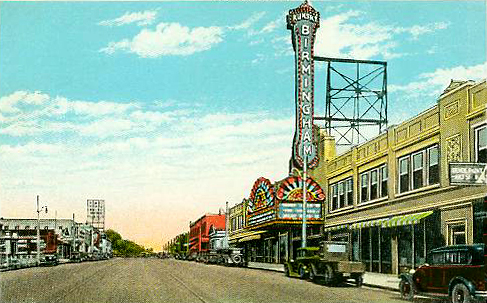

According to my perpetual calendar, Monday, October 31, 1927 was Halloween. I was 4 years and 11 months old. I remember going to the Baldwin High School Gym to see this very movie, LONG PANTS starring Harry Langdon.
Since this was after the 286 seat FAMILY THEATER had closed and prior to the opening of the KUNSKY BIRMINGHAM THEATRE, the High School Science Club, under the leadership of Mr. W. S. Toothacker, sponsored weekly movies at Baldwin.
About 12 years after the slide appearing above was used as a "coming attraction" announcement, I was sitting in Biology class at Baldwin High. I asked my teacher, Miss Frieda Huggett, what that strange room jutting into the lab was. On one wall there was about a 4 rung iron ladder leading up to a door not far from the ceiling. "Oh," she said, "that's the projection booth."
Needless to say, since I'd been a school movie operator for several years, I could hardly wait to climb up into that booth to find out what it contained. When I opened the door, I had a real surprise. Standing right in the middle of the room was a large and ancient 35mm silent projector. The feature which intrigued me most was its shutter. It was a disc mounted on a rather long rod. It had two holes which would allow light to reach the screen when it rotated IN FRONT of the projection lens. I have never encountered another shutter mechanism quite like that one.
On a bench at the side of the booth I found a shoe box full of glass slides. Soon after I began looking through them I was startled to discover the very slide that had been used to advertise the movie that I'd attended so many years before. Needless to say, that slide has never been out of my possession since then.
It was definitely Halloween night when I saw LONG PANTS. I recall that as we left the show and approached our Model-T coupe, my father was very displeased to note that some mischievous goblin had tugged on the choke wire protruding from the radiator, thus causing it to become misadjusted.
Maybe my memory is playing tricks with me, but I'm almost certain that on stage at Baldwin that same night were Ford and Glen, a nationally known comedy team. They traveled the country, staying several weeks at a time in a city where they would perform on one of its local radio stations.
They later became a threesome called Ford, Gene and Glenn. Ford left the team, not long afterward, and for years it was known as Gene and Glenn with Jake and Lena. Gene not only played his own part, but also changed his voice to become the rather goofy characters of Jake and Lena. Although they tended to stay fairly close to WTAM, Cleveland, I recall hearing them one night advertising R&G (Renewed and Guaranteed) used cars from WHO, Des Moines, Iowa.
When in Detroit, I believe that they normally worked at WJR. In early 1934 I saw them on stage at the old RKO DOWNTOWN. Do any of you reading this remember that theater?
No, LONG PANTS was not the first movie I attended. One afternoon in Pontiac I was introduced to films by viewing Charlie Chaplin's SHOULDER ARMS. The first film I recall seeing at the KUNSKY BIRMINGHAM was a silent version of PETER PAN.

Photo from the Winifred Quarton Collection
According to the BIRMINGHAM ECCENTRIC merchants overwhelmingly endorsed the idea of a PROSPERITY WEEK to be staged in conjunction with the opening of the new KUNSKY-BIRMINGHAM theater around November 17th, 1927. Shown above is the corner of Maple and Woodward festooned with banners in observance of that unusual celebration.

This Curt-Teich postcard provides an accurate view of the newly constructed KUNSKY-BIRMINGHAM and the office building which surrounded it.

A little more than a decade later, the city's third theater, THE BLOOMFIELD, was constructed on the east side of Woodward a short distance south of Brown St. Unlike the KUNSKY-BIRMINGHAM, the BLOOMFIELD was strictly a movie house. It lacked both the large, deep stage of its predecessor as well as dressing rooms for vaudeville performers or actors which might appear from time to time at the older theater. It was also somewhat smaller, seating about 900 patrons.
The next page is the first of several which will show how the construction of THE DETROIT UNITED RAILWAY contributed to the growth of Birmingham.
Click this link if you'd prefer to return to THE TABLE OF CONTENTS